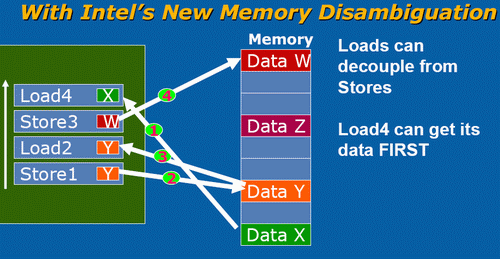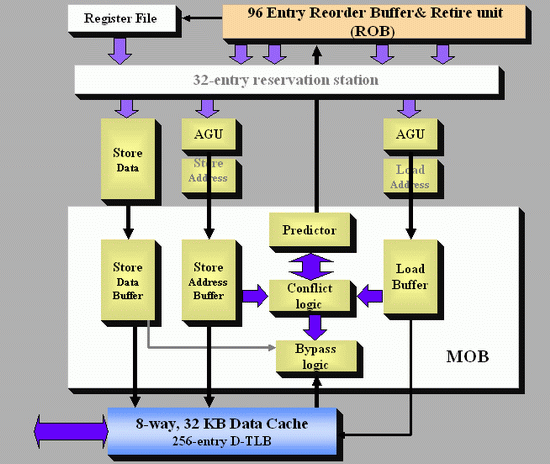Out of Order Loads done right
Since the Pentium Pro, x86 CPUs have been capable of issuing and executing instructions out of order. However, on average one third of the instructions in those reorder buffers could not be reordered easily: we are talking about loads. Moving loads forward can give a very big boost to performance. Instead of loading a piece of data when you need it, it is much more useful to start the load as early as you can. That way, L1 and even L2-cache latencies can be much more easily hidden.This is pretty easy to understand. Imagine having an ALU operation that needs a certain piece of data but that the data is not available in the L1-cache. If the load has been executed many cycles before the ALU operation needs that piece of data, the L2-cache latency is going to have a reduced impact. Of course, you don't want to load a value which is being or will be written to by a previous - following the program/thread order - store. That would mean you are loading an old value, not the up to date one. Check out the picture below.

Load 2 cannot be moved forward, since it has to wait until the first Store is done. Only after Store 1 is done will variable Y have its correct value. However there is no reason why Load 4 cannot move forward. It doesn't have to wait for Store 3 and store 1 to finish. By moving Load 4 forward, you give the load unit more time to get the right operand, as we assume that after load 4 a calculation with operand Y will happen.
Currently, CPUs will generally delay load 4 when a store is in flight (active). The problem is the address to which the stores will write has yet to be calculated. To be more precise, the memory addresses are still unknown during reordering and scheduling. When a Load micro-op enters the ROB, the memory addresses of previous stores (from the program order) are not known until they pass the AGU (Address Generation Units).
However, the risk that a load will load a value out of an address that is being written to by a store that has yet to be finished is pretty small (1-2%). That is why Jack Doweck of the Core development team decided to allow Loads to go ahead of previous stores, assuming that the load will not be loading information that will be updated by that preceding store. To avoid that the assumption was wrong, a predictor is used to help. The dynamic alias predictor tries to predict whether or not a previous store will write to the same address as the address from which the load - that you want to execute earlier, thus out of order - will load its data.
Based on Jack Doweck's comments and a study of Intel's previous P6 and P-M architectures I drew up the scheme below. Be warned that this is not the official Intel diagram.

The predictor gives the ReOrder Buffer (ROB) the permission to move a load ahead of a store or not. After the Load has been moved ahead and executed, the conflict logic scans the store buffer located in the Memory reOrder Buffer (MOB) to see if any of the stores which were located before the load (following program order) have written to the address of the out of order load. If so, the load must be redone, and the misprediction penalty is about 20 lost cycles. (Note that the branch misprediction penalty is also about 20 cycles). Worst case, the new dynamic alias predictor may slightly reduce performance, but realistically it's four steps forward, one step back, resulting in a net performance boost.
Determining whether a load and a store share the same address is called memory disambiguation. Allowing loads to move ahead of stores gives a big performance boost. In some snippets of benchmarking code, Intel saw up to a 40% performance boost, solely the result of the more flexible way Loads get reordered. It is pretty clear that we won't see this in most real applications, but it is nevertheless impressive and it should show tangible (10-20%) performance boosts together with the fast L2 and L1 cache.
Let us not forget that loads are probably the most important instructions of all. Not only are loads about one third of the micro-ops that are in flight in a x86 CPU, but they can also cause costly stalls when a load needs to go to the L2 cache (or worse, system memory). So how does this super flexible reordering of loads compare with other architectures?

The P6 and P-M could already reorder Loads pretty good. They could move one Load before other Loads, as well as before Stores which have no unknown addresses or addresses which do not reference the same address as the load. In contrast, the Athlon 64 can only move loads before independent ALU operations (ADD etc.). Loads cannot be moved ahead much at all to minimize the effect of a cache miss, and other loads cannot be used to keep the CPU busy if a load has to wait for a store to finish. This means that the Athlon 64 processor is severely limited when it comes to reorder code.
This is probably one of the most important reasons why the Athlon 64 does not outperform the P-M in gaming and integer workloads despite having a lower latency memory system and more integer execution sources. Integer workloads tend to jump around in memory, and have many unknown addresses which must be calculated first. It is less important for FP intensive loads, which is also one of the reasons why the Athlon 64 had no problem with Dothan in this kind of workload. FP workloads access the memory in a much more regular fashion.
Once Loads and Stores are in the queues of Load/Store units, the Athlon's L/S unit allows Loads to bypass Stores, except of course when the load would bypass a store to the same address. Unfortunately, by then the Loads are already out of the ICU and cannot be used to fill the holes that dependencies and cache misses make. You could say that the Athlon (64) has some Load/Store reordering but it's much later in the pipeline and is less flexible than the P6, P-M, and Core architectures.










87 Comments
View All Comments
thestain - Friday, May 5, 2006 - link
Larger Cache and an extra decoder were bound to help Conroe in the small and simple tesing done by most benchmarks.But, what about applications that are a bit larger than Conroe's cache size or those that are complex causing the simple decoders to not be able to be used that much while placing the single complex decoder on the Conroe into short supply?
Mike
IntelUser2000 - Friday, May 5, 2006 - link
LOL. You crack me up. Go see how much doubling of L2 caches help to increase performance. I guess the last 5 years of Netburst screwed people's mental abilities. Sure the caches will help Conroe, but if the CPU doesn't really need the extra cache, then it will be a waste. Kinda like how doubling L2 caches on Pentium D doesn't help a lot. Kinda like how doubling L2 caches on Athlon 64's don't help either. It's why Semprons excel.
About decoders. Guess you are still in the old ages where one of the reasons K7 was better than P6 was because it has the ability to decode complex instructions in all decoders. If you read about Conroe, more of the instructions that USED to go to the complex decoders can now go to the simple decoders.
And which benchmark would that be.
Guess there is gonna be a lot of AMD fanboys that are gonna cry when Conroe is shown.
stopkidding - Tuesday, May 2, 2006 - link
Did anyone notice that this comment thread is virtually free of the usual "Intel-this, AMD-that" comments that usually are seen on this site. The "fanbois" have nothing to bitch about as their little brains can't comprehend whats written in this article! :-)Reynod - Wednesday, May 3, 2006 - link
Which is a sigh of relief I must say. I can swallow hard facts and interpret code ... my 4400+ looks like going in as my new server box ... and my next gaming box looks like being an OC'd Conroe. I just won't buy an Intel Mobo ... heh heh.mino - Tuesday, May 2, 2006 - link
IMHO not, the article is extremely well written AND there are NO benchmarks => Intelman is happy from the text; AMD-man is hoping the real numbere won't be so bad...On topic, article is written in a very good style for general public.
On thing I'am afraid of is the moment code is optimized for Core, any other irchitecture would take a performance hit. K8 the smallest one, PM/K7 the small one, P4/P6 the big one and all older plus C7 e pretty huge hits.
That bothers me.
Except that, AMD will live for a long time (Opteron alone would survive them for 5+ yrs.) and X2's will be finally cheaper. What else to pray for :)
Best regards.
mino - Tuesday, May 2, 2006 - link
addennum:"the article is extremely well written FOR GENERAL AT AUDIENCE"
Otherwise job well done Johan.
nullpointerus - Tuesday, May 2, 2006 - link
Right, but then why do they respond to the other articles?JustAnAverageGuy - Tuesday, May 2, 2006 - link
Another top notch article, as always, Johan- JaAG
dguy6789 - Tuesday, May 2, 2006 - link
Thank you for writing this article. You have cleared up a large quantity of questions that I had in relation to the Core architecture.Betwon - Tuesday, May 2, 2006 - link
sub eax,[edi+ebx+79]There are 3 registers used: eax, edi, ebx
For Core duo, it decodes to one fusion-micro-op.
In the reservation station (RS), only one entry is needed to be allocated. There are three registers spaces in one RS entry at least. And the results of address(edi+ebx+79) can be w rited back into the same position of one register in this RS entry.(A replace method)
For K7/K8, it decodes to one macro-op?
In the reservation station (RS), only one entry is needed to be allocated? There are three registers spaces in one RS entry?
It can take one entry in ROB.
But I don't believe AMD. It may take two entrys in RS, because there are only two registers spaces in one RS entry of K8. K8 hasn't three registers spaces in one RS entry.
K8's RS is up to 8X3 macro-op, but not means that one macro-op can always take one entry in the RS.
I say that I don't believe AMD.
Of course, Other people have on need to believe me too.